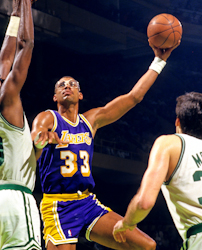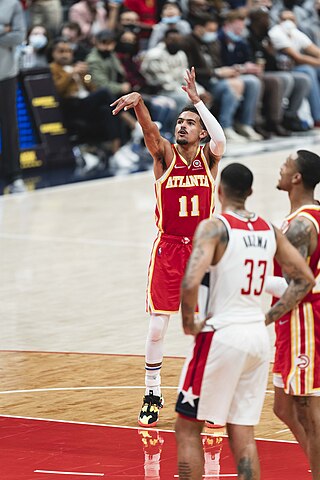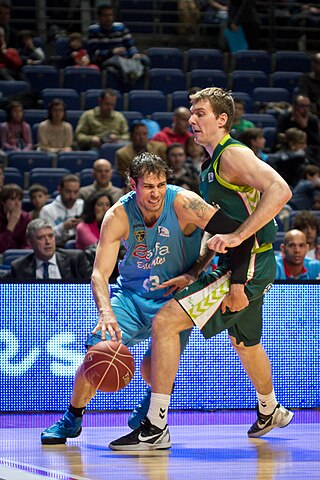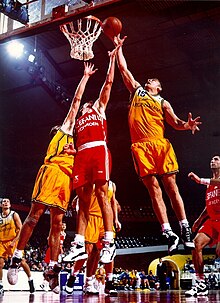
Wilton Norman Chamberlain was an American professional basketball player. Standing 7 ft 1 in (2.16 m) tall, he played center in the National Basketball Association (NBA) for 14 seasons and is widely regarded as one of the sport's greatest players. Chamberlain was enshrined in the Naismith Memorial Basketball Hall of Fame in 1978 and elected to the NBA's 35th, 50th, and 75th anniversary teams. Following his professional basketball career, Chamberlain played volleyball in the short-lived International Volleyball Association (IVA). He served one term as league president and is enshrined in the IVA Hall of Fame. Renowned for his strength, he played the antagonist in the 1984 Arnold Schwarzenegger film, Conan the Destroyer. Chamberlain was also a lifelong bachelor and became well known for his claim of having had sex with 20,000 women.

Jerome Alan West is an American basketball executive and former player. He played professionally for the Los Angeles Lakers of the National Basketball Association (NBA). His nicknames included "the Logo", in reference to his silhouette being the basis for the NBA logo; "Mr. Clutch", for his ability to make a big play in a key situation such as his famous buzzer-beating 60-foot shot that tied Game 3 of the 1970 NBA Finals against the New York Knicks; "Mr. Outside", in reference to his perimeter play with the Los Angeles Lakers and "Zeke from Cabin Creek" for the creek near his birthplace of Chelyan, West Virginia. West played the small forward position early in his career: he was a standout at East Bank High School and at West Virginia University, where he led the Mountaineers to the 1959 NCAA championship game. He earned the NCAA Final Four Most Outstanding Player honor despite the loss. He then embarked on a 14-year career with the Los Angeles Lakers and was the co-captain of the 1960 U.S. Olympic gold medal team, a squad that was inducted as a unit into the Naismith Memorial Basketball Hall of Fame in 2010.

Andrei Gennadyevich Kirilenko is a Russian-American basketball executive and former professional basketball player.

The center (C), or the centre, also known as the five or the pivot, is one of the five positions in a regulation basketball game. The center is normally the tallest player on the team, and often has a great deal of strength and body mass as well. In the NBA, the center is typically close to 7 feet (2.13 m) tall. They traditionally play close to the basket in the low post. The tallest players to play the position in NBA history are Manute Bol and Gheorghe Mureșan, both of whom stood at 7 feet and 6 inches tall.

In basketball, free throws or foul shots are unopposed attempts to score points by shooting from behind the free-throw line, a line situated at the end of the restricted area. Free throws are generally awarded after a foul on the shooter by the opposing team, analogous to penalty shots in other team sports. Free throws are also awarded in other situations, including technical fouls, and when the fouling team has entered the bonus/penalty situation. Also, depending on the situation, a player may be awarded between one and three free throws. Each successful free throw is worth one point.

In basketball, a personal foul is a breach of the rules that concerns illegal personal contact with an opponent. It is the most common type of foul in basketball. A player fouls out on reaching a limit on personal fouls for the game and is disqualified from participation in the remainder of the game.

Moses Eugene Malone Sr. was an American professional basketball player who played in both the American Basketball Association (ABA) and the National Basketball Association (NBA) from 1974 through 1995. A center, he was named the NBA Most Valuable Player (MVP) three times, was a 12-time NBA All-Star and an eight-time All-NBA Team selection. Malone led the Philadelphia 76ers to an NBA championship in 1983, winning both the league and Finals MVP. He was inducted into the Naismith Memorial Basketball Hall of Fame in his first year of eligibility in 2001. Widely regarded as one of the greatest players in the sport's history, Malone is also seen as one of the most underrated NBA players.

Robert E. Lee Pettit Jr. is an American former professional basketball player. He played 11 seasons in the NBA, all with the Milwaukee/St. Louis Hawks (1954–1965). In 1956, he became the first recipient of the NBA's Most Valuable Player Award and he won the award again in 1959. He also won the NBA All-Star Game MVP award four times. As of the end of 2022-2023 regular season, Pettit is still the only regular season MVP in the history of the Hawks, despite the team relocating to Atlanta following his retirement in 1965.

Hack-a-Shaq is a basketball defensive strategy used in the National Basketball Association (NBA) that involves committing intentional fouls for the purpose of lowering opponents' scoring. The strategy was originally adapted by Dallas Mavericks coach Don Nelson, who directed players to commit personal fouls throughout the game against selected opponents who shot free throws poorly.

Elvin Ernest Hayes, nicknamed "the Big E", is an American former professional basketball player and radio analyst for his alma mater Houston Cougars. He is a member of the NBA's 50th and 75th anniversary teams, and an inductee in the Naismith Memorial Basketball Hall of Fame. Known for both his offensive and defensive prowess, Hayes is often regarded as one of the best power forwards in NBA history. Hayes is also known for his longevity, being third all-time in NBA minutes played, and missing only nine games during his 16-season career.

Caldwell "Pops" Jones Jr. was an American professional basketball player.

In basketball, a steal occurs when a defensive player legally causes a turnover by their positive, aggressive action(s). This can be done by deflecting and controlling, or by catching the opponent's pass or dribble of an offensive player. The defender must not touch the offensive player's hands or otherwise a foul is called.

This glossary of basketball terms is a list of definitions of terms used in the game of basketball. Like any other major sport, basketball features its own extensive vocabulary of unique words and phrases used by players, coaches, sports journalists, commentators, and fans.

Wilt Chamberlain set the single-game scoring record in the National Basketball Association (NBA) by scoring 100 points for the Philadelphia Warriors in a 169–147 win over the New York Knicks on March 2, 1962, at Hershey Sports Arena in Hershey, Pennsylvania. It is widely considered one of the greatest records in the sport's history. Chamberlain set five other league records that game including most free throws made, a notable achievement, as he was regarded as a poor free throw shooter. Both teams broke the record for most combined points in a game (316).
The 1957 NCAA University Division Basketball Championship Game took place on March 23, 1957, between the North Carolina Tar Heels and the Kansas Jayhawks at the Municipal Auditorium in Kansas City, Missouri. The matchup was the final one of the nineteenth edition of the single-elimination tournament now known as the NCAA Division I men's basketball tournament—commonly referred to as the NCAA Tournament—organized by the National Collegiate Athletic Association (NCAA). It was used to crown a national men's basketball champion in the NCAA's University Division, known since 1973 as the NCAA Division I.
Basketball is a ball game and team sport in which two teams of five players try to score points by throwing or "shooting" a ball through the top of a basketball hoop while following a set of rules. Since being developed by James Naismith as a non-contact game that almost anyone can play, basketball has undergone many different rule variations, eventually evolving into the NBA-style game known today. Basketball is one of the most popular and widely viewed sports in the world.




















